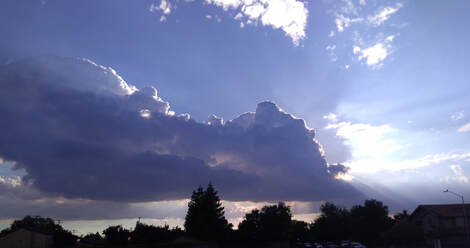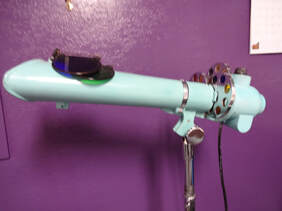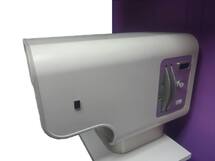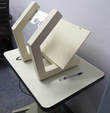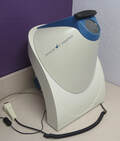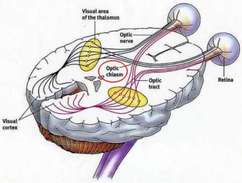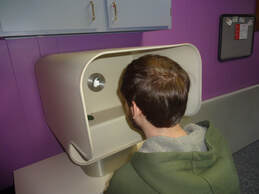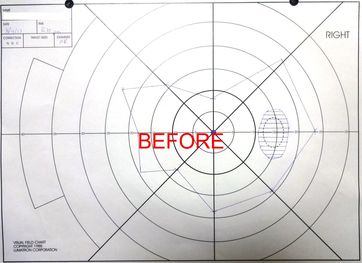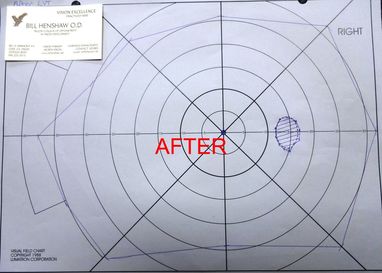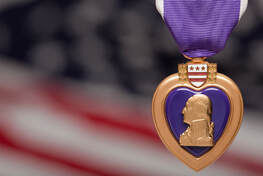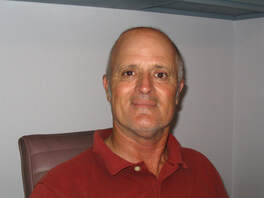|
LIGHT THERAPY
Have you seen the light?. SEEING THE LIGHT MAY CHANGE OR EVEN SAVE YOUR LIFE What kind of light would do that, and how could that light change or save your life (see step #3 below)? They are colored lights prescribed individually for certain vision conditions based on years of scientific studies. |
They are shined into your eyes. They can open up your peripheral vision and save you from a traffic mishap. They can resolve persistent headaches, make learning easier, and even help cataracts and macular degeneration. Science is beginning to find more and more uses for light therapy.

You may be aware that some experience depression in the winter from clouds blocking the sun's ultraviolet rays called Seasonal Affective Disorder(SAD).
|
SAD is treated simply by illuminating with ultraviolet (UV) lighting, long advocated by the Walt Disney slow motion photographer John Ott. If simple UV light can cause such a change, imagine what a prescriptive colored light shined directly in your yes can do. As you will see below, it does a lot.
Incidentally, the ceiling lighting in our office is UV producing. UV is pleasant to the eye, avoids florescent flicker, matches color correctly as seen in sunlight, and even kills COVID and other virus strains. |
|
LIGHT THERAPY IN OUR OFFICE
Although one of the early advocates of light therapy Dr. Calvin Looser from whom Dr. Henshaw purchased this office practiced light therapy for years, Dr. Henshaw did not follow his footsteps until an optometric colleague knew Dr. Henshaw had one of Dr. Looser’s old instruments and asked him to help with a patient who lived closer to our office. The results led Dr. Henshaw to attend the College of Syntonics annual meeting in Denver in 1988. |
Working closely with Dr. Fast in Sacramento, Dr. Henshaw helped many of his patients. It was not until the Annual meeting in San Diego in 2011 that Dr. Henshaw became a member of the College of Syntonic Optometry.
|
|
Who may need light therapy? We first were introduced to light therapy as a treatment of peripheral vision loss and headaches from auto accidents. After years of success, some phenomenal, (Blake’s blindness due to peripheral vision loss was cured in ten days- see testimony below), patients asked about natural cures for cataracts. Once starting that it was not long before macular degeneration care began.
|
|
We started with Dr. Looser’s classic instrument and advanced to Dr. John Downing’s more modern instrument. We now have units that can be used at home. Most recently we added goggles with the prescriptive color in them for home use. Books have been written about light therapy. My favorite is Light Medicine of the Future by Jacob Liberman, OD, PHD
|

HOW DOES LIGHT THERAPY TAKE PLACE IN THE OFFICE?
1. Like in all treatment, it starts with the case history. We ask about automobile accidents, head trauma, and whip lash.
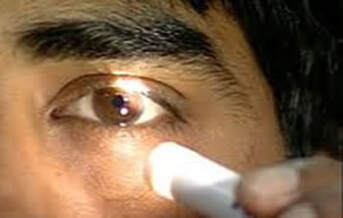
2. A careful check of the pupil reflex can indicate whether a head injury or whiplash has taken place anytime in the past. We are looking for an alpha/Omega pupil response. When a light is shined at the pupil rather than staying constricted (smaller) as it is supposed to do, it quickly opens. The scale varies from zero to 4, with zero being no effect.
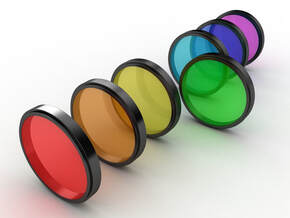
4. Once all of the above is collected we design the prescription of the colored lights to be used with each patient’s vision system. Then you simply look into an instrument that displays a prescriptive colored light.
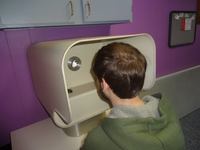
Treatment consists of ten 22-minute sessions. Two minutes are spent on adaption while two more 10-minute sessions with different prescriptive colors follow. After ten sessions the vision fields are repeated to determine the changes.
We’ve had unexpected changes take place. Self confidence has enhanced and one 10 year old even stopped bed-wetting. Another regained increased use of a paralyzed hand. A stroke sufferer who lost 50% of his side vision, gained 80% of it back. Medicine has long held you can not regain side vision loss from a stroke.
The concussion doctor comes to Lodi
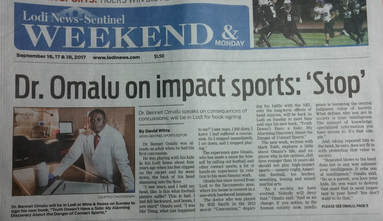
In the past, the Lodi News Sentinel reported on a book signing by Dr. Omalu, our Coroner and the man behind the movie Concussion starring Will Smith. He discovered football players had brain damage by examining their brains after death. It caused the NFL to take precautions and other sports took a look.
|
Dr. Omalu recommends kids avoid football, boxing and other contact sports. |
|
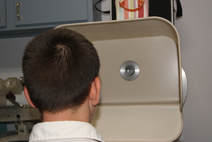
For years optometry has tested and treated the vision consequences of head trauma and concussion. We unlike Dr. Omalu, can test while the patient is alive. Even more, we can treat the conditions with light therapy. Head trauma or even whiplash results in damage to binocular vision, near vision focusing, side vision and blind spots, and vision processing. The disorientation and headaches people feel after an automobile accident mainly results from that vision damage. Treatment with light therapy quickly reduces or eliminates the headaches (see Blake's story below).
|
For over twenty years we have used a test, the Developmental Eye Movement test (DEM). You read a series of numbers as rapidly as possible. The test evolved from a Dr. Pierce. Drs King and Devick added to it. Next came the DEM. Recently Dr. Steve Devick enhanced the test under King-Devick technologies, INC. which the famed Mayo Clinic uses to determine presence of a concussion. Thus, it has a dual use.
Frankly, we were way ahead of Dr. Omalu. He simply proved through autopsy what we believed for years. In 1998 we discovered a high school soccer player with reduced vision fields and advised no more heading. Please do not think I'm over critical. Dr. Omalu's work is valuable and resulted in many positive changes. |
|
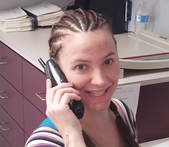
Should you suffer an auto accident, sports injury, or any head trauma or whiplash give us a call at 334 -2020.
The College of Optometrists in Vision Development Recognizes
March is Brain Injury Awareness Month:
Missing Link to the Rehabilitation Process
Heading in Soccer
Frequent 'Heading' in Soccer Can Lead to Brain Injury and Cognitive Impairment.
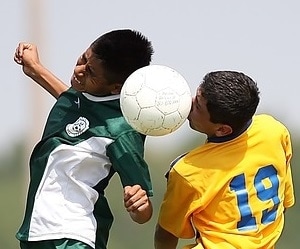
Researchers at Albert Einstein College of Medicine of Yeshiva University and Montefiore Medical Center, the University Hospital and academic medical center for Einstein, have shown that repeatedly heading a soccer ball increases the risk for brain injury and cognitive impairment.* The findings are especially concerning given that soccer is the world's most popular sport with popularity growing in the U.S., especially among children. Soccer balls are known to travel at speeds as high as 34 miles per hour during recreational play, and more than twice that during professional play.
The study presents compelling evidence That traumatic brain injury ( TBI ) and cognitive impairment can result from heading a soccer ball with high frequency.
Another similar study was done by Elizabeth Larson at Humboldt State College Kinesology Department with the same results.**
Our office both tests and treats the vision effects of TBI . We have two essential tests to determine the damage if any from TBI. One that is age related is important for youth sports. Any blow to the head, even a whiplash, affects side vision, near vision clarity, two eyed vision, and vision processing.
Should you have any interest in testing of any of your athletes or suspect a potential problem we are available to test and treat.
*JAMA. 2012307(10):1012-1014. doi:10.1001/jama.2012.231
**A COMPREHENSIVE PROSPECTIVE ANALYSIS OF SOCCER HEADING AMONG MALE AND FEMALE COLLEGIATE SOCCER ATHLETES May, 2011
The study presents compelling evidence That traumatic brain injury ( TBI ) and cognitive impairment can result from heading a soccer ball with high frequency.
Another similar study was done by Elizabeth Larson at Humboldt State College Kinesology Department with the same results.**
Our office both tests and treats the vision effects of TBI . We have two essential tests to determine the damage if any from TBI. One that is age related is important for youth sports. Any blow to the head, even a whiplash, affects side vision, near vision clarity, two eyed vision, and vision processing.
Should you have any interest in testing of any of your athletes or suspect a potential problem we are available to test and treat.
*JAMA. 2012307(10):1012-1014. doi:10.1001/jama.2012.231
**A COMPREHENSIVE PROSPECTIVE ANALYSIS OF SOCCER HEADING AMONG MALE AND FEMALE COLLEGIATE SOCCER ATHLETES May, 2011
|
|
WHO HAVE WE HELPED WITH LIGHT THERAPY?
Syntonics or light therapy has been around for a long time, but the emphasis on concussions has brought it into popularity. Syntonics is the science of shining prescriptive colored light into the eye to enhance vision and health. |
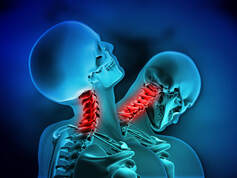
It is most commonly used for people who have had a blow to the head or whiplash, commonly found in auto accidents. Once that happens people's side vision is reduced and blind spots are enlarged. Headaches are common after. Light therapy rapidly alleviates the headaches and repairs the vision fields.
Y. R. was hit in the forehead a few years earlier. Enclosed is a vision field of her right eye on 3/9/17 She started light therapy on 3/20/17 and finished 3/31/17. Enclosed is her vision right field on 4/11/17. Obviously that was a big change. Yet, that is typical of treatment with light therapy. If you have had an auto accident or any head injury we may be able to help. The time of the accident does not seem to matter. We helped Blake 30 years after his war injury that was ignored by the Army. See Blake’s story below.

I am 59 years old. I received a head injury almost 40 years ago in the Military during the Vietnam conflict. I was told my left hand was paralyzed, 10% of my memory was gone, and I had blind spots due to the injury. Since the head injury I have been a subject for an ongoing study by the Military for head injuries.
I have completed 2 years of college and worked 25 years as a Federal employee.
I have completed 2 years of college and worked 25 years as a Federal employee.
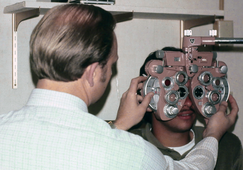
During a routine vision examination Dr. Henshaw not only provided me with a better vision exam than the military, he discovered problems the military missed. I had an eye turn outward, vision processing problems beyond the 10% memory loss the military reported, and the vision field loss the military mentioned.
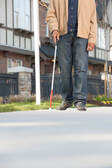
What the military neglected to tell me is that my vision field loss was so restricted that I was legally blind. [see #4] Yes, I was driving legally blind for 30 years. Dr. Henshaw said I would be a good candidate for Vision Therapy, and I want to thank the doctor and his staff. Through light therapy within only 5 days my side vision was improved dramatically, and I was no longer legally blind. I'm much more confident with my driving skills now.

I also gained control of my outward turned eye through vision therapy and improved my vision processing skills. Yet, more important to me, I have regained a significant amount of the use of my left hand. Now I can do simple things that are taken for granted. I can throw a ball, work a clutch on a motorcycle and a hand brake on a bicycle.
I will leave it to the Doctor to explain how these things are possible. I am looking forward to the time when I go back for the head injury study by the military. Then it will be documented - the positive results of Dr. Henshaw's Therapy.
signed: Blake Mutschler
I will leave it to the Doctor to explain how these things are possible. I am looking forward to the time when I go back for the head injury study by the military. Then it will be documented - the positive results of Dr. Henshaw's Therapy.
signed: Blake Mutschler
Headaches Gone!
Until I was treated by Dr Henshaw I suffered painful disabling headaches that would last prolonged periods. This was despite excellent chiropractic treatments from my husband. You may imagine what it felt like to bear the pain and be unable to perform simple tasks like reading, computer, or house work because of the intense pain. The headaches were a major interference in my life.
Dr Henshaw discovered the source of the headaches, an disturbance in my side vision, and applied a simple non-invasive treatment. I imagine those of you reading this who have headaches are taking sundry medications with many side effects just to rid the pain. Dr. Henshaw ‘s simple treatment was light therapy. I simply looked at colored lights prescriptive to my vision condition for 20 minutes sessions. By the end of treatment my headaches disappeared and only rarely have come back and not in the intensity they were before.
signed Cathy
Until I was treated by Dr Henshaw I suffered painful disabling headaches that would last prolonged periods. This was despite excellent chiropractic treatments from my husband. You may imagine what it felt like to bear the pain and be unable to perform simple tasks like reading, computer, or house work because of the intense pain. The headaches were a major interference in my life.
Dr Henshaw discovered the source of the headaches, an disturbance in my side vision, and applied a simple non-invasive treatment. I imagine those of you reading this who have headaches are taking sundry medications with many side effects just to rid the pain. Dr. Henshaw ‘s simple treatment was light therapy. I simply looked at colored lights prescriptive to my vision condition for 20 minutes sessions. By the end of treatment my headaches disappeared and only rarely have come back and not in the intensity they were before.
signed Cathy
|
Does age matter?
Picture #1 is the vision field of 95-year-old Gene after an auto accident. Picture #2 is the result after 10 visits of light therapy. Another 10 visits will improve the blind spot even more. We were testing Gene to determine if light therapy and vision therapy were necessary. His vision field showed minor changes of which treatment was questionable. Just after testing, he was involved in an auto accident of no fault of his. As you can see from the changes in his vision field even the elderly can be helped. It is discouraging to hear, "I am too old to fix my vision. Why should I bother?" |
|
|
|
News Release 23-Feb-2022
Cognitive brain function in youth football players can be impaired by repetitive “subconcussive” head impacts Peer-Reviewed Publication HealthTech Connex Inc. Brain Vital Signs youth football concussion study Credit: HealthTech Connex Inc. |
Sioux Falls, South Dakota, U.S. and Surrey, British Columbia, Canada (February 23, 2021) – Neuroscience researchers at Sanford Research in Sioux Falls, South Dakota, U.S., Simon Fraser University (SFU), and HealthTech Connex Inc. located at the Health and Technology District in Surrey, British Columbia, Canada, have published the latest results of their ongoing multi-year football study examining subconcussive changes in cognitive brain function in male youth football players.
The findings were recently published in the peer-reviewed journal Brain Communications in the advanced articles section, titled: “Subconcussive changes in youth football players: Objective evidence using brain vital signs and instrumented accelerometers.”
The research team monitored the brain vital signs of 15 male youth football players (age 14 or under) in Sioux Falls, South Dakota, during pre- and post-season play who did not sustain a concussion diagnosis during the season.
“Brain vital signs” translates complex brain waves measured using portable electroencephalography (EEG) into simple, fast, user-friendly and intuitive results that provide an objective evaluation of cognitive brain function. Called the ABCs of brain function, brain vital signs track three well-established neural responses for Auditory sensation (using a response called the N100), Basic attention (using a response called the P300), and Cognitive processing (using a response called the N400).
The study examined this group of male youth football players and reported cognitive processing sensitivity (N400) to subconcussive impairments in those players who did not sustain a concussion diagnosis over the course of the season. In addition, changes in brain vital signs were highly related to the number of head impacts that the players were exposed to during the season.
This youth football study replicated and built on previous Junior-A and Bantam youth ice hockey concussion and subconcussion study results published in Brain: A Journal of Neurology and Brain Communications which resulted in the same findings, confirming significant brain vitals sign changes and concussive/subconcussive impairments in youth contact sport that went undetected using current clinical concussion protocols.
A subconcussive impact is a mechanical force transmitted to the brain below the threshold for a diagnosis of an acute concussive injury. The effects of these low-magnitude impacts may not even be noticeable to the player or to observers on the sideline.
“By monitoring brain vital signs, extracted from complex brain waves measured using portable electroencephalography (EEG), it was possible for us to track three well-established neural responses for auditory sensation, basic attention, and cognitive processing in these youth football players,” says Dr. Thayne Munce, the study’s principal investigator and Assistant Scientist in the Environmental Influences on Health and Disease Group at Sanford Research. “The results of the study show that repetitive subconcussive impacts triggered compounding effects in brain function changes over time. While more research needs to be done in this area, this is the first step in how we can look at youth contact sports in the future.”
The results of this youth football Brain Communications study showed:
Significant brain vital sign changes in pre-to-post season cognitive processing speed.
A significant relationship between the subconcussive brain vital sign changes and head impact exposures as measured by the total number of head impacts as well as number of games and/or practices over the season.
The authors noted that the brain vital sign changes and total number of head impacts for the football players closely related with the results from older, Junior-A, ice hockey players from a previous study.
Canadian collaborators include neuroscientist Dr. Shaun Fickling, lead R&D scientist at HealthTech Connex Inc., SFU PhD graduate and lead author of the study, as well as Dr. Ryan D’Arcy, an SFU professor and co-founder of HealthTech Connex Inc. and the Health and Technology District in Surrey B.C. HealthTech Connex Inc. is a health technology company developing the NeuroCatch® Platform.
“These findings provide further support that there is a predictive relationship between head impact exposure in contact sport and subtle changes in cognitive brain function” reports Dr. Shaun Fickling, who was the study’s lead author as part of his PhD in Biomedical Engineering at Simon Fraser University.
“The results are really quite positive and optimistic for the future of brain injury prevention and management in sport,” further explains Dr. Thayne Munce. “Now that we can sensitively detect changes associated with subconcussive impacts, it is possible to identify the leading ways to prevent, treat, and manage possible impairments, which is a critical step that is now getting underway.”
The US-Canadian concussion research collaborators are continuing to utilize these brain vital sign advances to evaluate possible leading innovations in prevention and treatment.
The research study was designed and carried out by investigators at Sanford Research, and partially supported by a grant from the T. Denny Sanford Pediatric Collaborative Research Fund. This project was also supported in part by the Simon Fraser University Graduate International Travel and Research Award (GIRTA).
About Sanford Health:
Sanford Health, one of the largest health systems in the United States, is dedicated to the integrated delivery of health care, genomic medicine, senior care and services, global clinics, research and affordable insurance. Headquartered in Sioux Falls, South Dakota, the organization includes 46 hospitals, 1,500 physicians and more than 200 Good Samaritan Society senior care locations in 26 states and 10 countries. Learn more about Sanford Health’s transformative work to improve the human condition at Sanford Health News.
About Simon Fraser University (SFU):
As Canada’s engaged university, SFU works with communities, organizations and partners to create, share and embrace knowledge that improves life and generates real change. We deliver a world-class education with lifelong value that shapes change-makers, visionaries and problem-solvers. We connect research and innovation to entrepreneurship and industry to deliver sustainable, relevant solutions to today’s problems. With campuses in British Columbia’s three largest cities—Vancouver, Burnaby and Surrey—SFU has eight faculties that deliver 193 undergraduate degree programs and 127 graduate degree programs to more than 37,000 students. The university now boasts more than 165,000 alumni residing in 143 countries. www.sfu.ca
About HealthTech Connex Inc.
Located in the Health and Technology District, HealthTech Connex Inc. (HTC) is a brain technology company focusing on cutting-edge innovations and services for rapid impact on health improvements and outcomes in neurological performance. With brain vitality as a premier focus, HealthTech Connex provides translational neuroscience innovations to care and community sectors worldwide, bridging the gap between what’s capable in the laboratory and what’s available in the real world. www.healthtechconnex.com
Media contact: Yvonne Chiang [email protected]
The findings were recently published in the peer-reviewed journal Brain Communications in the advanced articles section, titled: “Subconcussive changes in youth football players: Objective evidence using brain vital signs and instrumented accelerometers.”
The research team monitored the brain vital signs of 15 male youth football players (age 14 or under) in Sioux Falls, South Dakota, during pre- and post-season play who did not sustain a concussion diagnosis during the season.
“Brain vital signs” translates complex brain waves measured using portable electroencephalography (EEG) into simple, fast, user-friendly and intuitive results that provide an objective evaluation of cognitive brain function. Called the ABCs of brain function, brain vital signs track three well-established neural responses for Auditory sensation (using a response called the N100), Basic attention (using a response called the P300), and Cognitive processing (using a response called the N400).
The study examined this group of male youth football players and reported cognitive processing sensitivity (N400) to subconcussive impairments in those players who did not sustain a concussion diagnosis over the course of the season. In addition, changes in brain vital signs were highly related to the number of head impacts that the players were exposed to during the season.
This youth football study replicated and built on previous Junior-A and Bantam youth ice hockey concussion and subconcussion study results published in Brain: A Journal of Neurology and Brain Communications which resulted in the same findings, confirming significant brain vitals sign changes and concussive/subconcussive impairments in youth contact sport that went undetected using current clinical concussion protocols.
A subconcussive impact is a mechanical force transmitted to the brain below the threshold for a diagnosis of an acute concussive injury. The effects of these low-magnitude impacts may not even be noticeable to the player or to observers on the sideline.
“By monitoring brain vital signs, extracted from complex brain waves measured using portable electroencephalography (EEG), it was possible for us to track three well-established neural responses for auditory sensation, basic attention, and cognitive processing in these youth football players,” says Dr. Thayne Munce, the study’s principal investigator and Assistant Scientist in the Environmental Influences on Health and Disease Group at Sanford Research. “The results of the study show that repetitive subconcussive impacts triggered compounding effects in brain function changes over time. While more research needs to be done in this area, this is the first step in how we can look at youth contact sports in the future.”
The results of this youth football Brain Communications study showed:
Significant brain vital sign changes in pre-to-post season cognitive processing speed.
A significant relationship between the subconcussive brain vital sign changes and head impact exposures as measured by the total number of head impacts as well as number of games and/or practices over the season.
The authors noted that the brain vital sign changes and total number of head impacts for the football players closely related with the results from older, Junior-A, ice hockey players from a previous study.
Canadian collaborators include neuroscientist Dr. Shaun Fickling, lead R&D scientist at HealthTech Connex Inc., SFU PhD graduate and lead author of the study, as well as Dr. Ryan D’Arcy, an SFU professor and co-founder of HealthTech Connex Inc. and the Health and Technology District in Surrey B.C. HealthTech Connex Inc. is a health technology company developing the NeuroCatch® Platform.
“These findings provide further support that there is a predictive relationship between head impact exposure in contact sport and subtle changes in cognitive brain function” reports Dr. Shaun Fickling, who was the study’s lead author as part of his PhD in Biomedical Engineering at Simon Fraser University.
“The results are really quite positive and optimistic for the future of brain injury prevention and management in sport,” further explains Dr. Thayne Munce. “Now that we can sensitively detect changes associated with subconcussive impacts, it is possible to identify the leading ways to prevent, treat, and manage possible impairments, which is a critical step that is now getting underway.”
The US-Canadian concussion research collaborators are continuing to utilize these brain vital sign advances to evaluate possible leading innovations in prevention and treatment.
The research study was designed and carried out by investigators at Sanford Research, and partially supported by a grant from the T. Denny Sanford Pediatric Collaborative Research Fund. This project was also supported in part by the Simon Fraser University Graduate International Travel and Research Award (GIRTA).
About Sanford Health:
Sanford Health, one of the largest health systems in the United States, is dedicated to the integrated delivery of health care, genomic medicine, senior care and services, global clinics, research and affordable insurance. Headquartered in Sioux Falls, South Dakota, the organization includes 46 hospitals, 1,500 physicians and more than 200 Good Samaritan Society senior care locations in 26 states and 10 countries. Learn more about Sanford Health’s transformative work to improve the human condition at Sanford Health News.
About Simon Fraser University (SFU):
As Canada’s engaged university, SFU works with communities, organizations and partners to create, share and embrace knowledge that improves life and generates real change. We deliver a world-class education with lifelong value that shapes change-makers, visionaries and problem-solvers. We connect research and innovation to entrepreneurship and industry to deliver sustainable, relevant solutions to today’s problems. With campuses in British Columbia’s three largest cities—Vancouver, Burnaby and Surrey—SFU has eight faculties that deliver 193 undergraduate degree programs and 127 graduate degree programs to more than 37,000 students. The university now boasts more than 165,000 alumni residing in 143 countries. www.sfu.ca
About HealthTech Connex Inc.
Located in the Health and Technology District, HealthTech Connex Inc. (HTC) is a brain technology company focusing on cutting-edge innovations and services for rapid impact on health improvements and outcomes in neurological performance. With brain vitality as a premier focus, HealthTech Connex provides translational neuroscience innovations to care and community sectors worldwide, bridging the gap between what’s capable in the laboratory and what’s available in the real world. www.healthtechconnex.com
Media contact: Yvonne Chiang [email protected]
|
So, you had an automobile accident: |
|
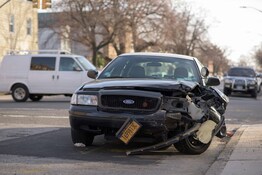
The day you wish never happened
|
A visit to the Emergency room
|
|

Then they told you everything was okay:
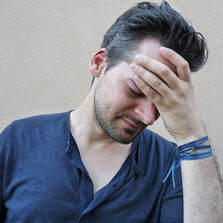
... but it wasn’t:
|
|
The day you found there might be an answer. |
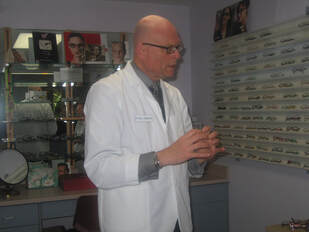
Hope was given:
|
|
What you first saw in your special side vision test: |
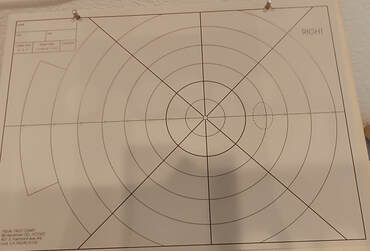
The target you saw:
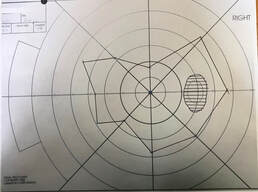
The result of your vision field.
|
The treatment: |
|
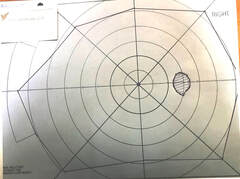
The result: Not only did the vision field improve but the headaches, nausea, and fogginess disappeared.
